Coursework: Development of a cargo transportation information system. Review of the best software systems in the field of freight transportation and logistics
Online service For operational work freight forwarding companies. Create transportation requests, organize documents, monitor the work of logistics managers, and monitor the company’s profitability.
Online business management system in the field of cargo transportation. The purpose of the system is to ensure timely exchange of information, SaaS document flow between customers, cargo carriers and freight forwarding companies in a single information space using the Internet portal.
A cloud service for automating transport logistics and can be delivered both in SaaS format and with installation on customer servers. Allows you to optimize routes. Integration of GLONASS/GPS with transport monitoring.
A program for accounting for your own fleet of vehicles, documents related to accounting, generating and printing waybills, accounting for repairs and maintenance performed, accounting for fuel and lubricants, the work of drivers, accounting for contractors and working with them, warehouse accounting.
Online program for maintaining secure document flow for cargo transportation. Organization of a systematic approach to processing applications and full transparency of the process from receipt of an application for transportation to the arrival of the cargo at its destination
Online service for automating all processes of a transport company. Allows you to create and control applications, maintain acts and technical specifications, salaries, generate reports
Cloud SaaS solution designed for automatic planning of delivery routes. The operation of the logistics program is based on a unique algorithm that optimally plans routes, taking into account all restrictions, and also selects the optimal sequence of routes and the most suitable from the point of view technical capabilities and the cost of transport.
A robotic software package for automating accounting and management at a motor transport enterprise. It combines all the resources and processes of a motor transport enterprise into one convenient management system.
1C configuration for vehicle accounting. The program allows you to keep track of fuel and lubricants, waybills, monitor routine maintenance, carry out dispatch functions, and monitor the availability and relevance of driver documents. Cars are stored in car parks and bays, and the availability of cars in the bays is monitored. A mechanism for warehouse accounting of fuels and lubricants, spare parts and other material assets has been implemented.
A system for automating management and operational accounting in motor transport enterprises, as well as in transport departments of trading, manufacturing and other companies with various industry specifics.
A program for transport companies and forwarders, as well as any logistics departments of enterprises whose activities are in one way or another related to transportation: cargo transportation, road transportation, delivery, etc.
The system based on 1C:Enterprise 8 comprehensively automates all business processes of vehicle management at enterprises of any size and industry.
A software package for managing road transportation that has all the functionality required by most freight forwarding companies.
Configuration for recording waybills in 1C with extensive capabilities and a familiar interface.
A program for cargo transportation that can manage the process of cargo delivery. Dispatcher's workplace mobile app for the driver, SMS information, reporting
Program for automation of freight transportation and logistics. A CRM system (TMS system) that will simplify transportation accounting and automate all processes of a transport enterprise. Solutions for managers, logisticians, dispatchers, accountants, as well as control tools for the head of the transport department.
Federal Agency for Education of the Russian Federation
Branch of the State Educational Institution of Higher Professional Education "Saratov State Technical University" in Petrovsk
Course work
Discipline: “Development technology software product»
Topic: Development information system"cargo transportation"
Completed by: 3rd year student
Specialties 230105.51
« Software computer technology and automated systems»
Shikhin Gleb
Checked by: teacher
Trubkina Yu.A
Petrovsk 2010
| Introduction I. Technical specifications 2.Carrying out research work 2.1.Define input and output data structures 2.2. Requirements for composition and parameters technical means PC 2.3. Requirements for information and software compatibility II. Economical project. Explanatory note 1. Justification for the need to develop an application 2. Statement of the development problem, description of solution methods 2.1.Database structure 2.2.Diagrams 2.2.1 Sequence diagram 2.2.2.Sequence diagram 2.2.3.Action diagram 2.2.4.Diagram 2.3.User instructions 3.Description and justification for choosing the composition of technical and software Brief characteristics operating room Windows systems XP Conclusion Bibliography |
Introduction
My theme course work Development of the Cargo Transportation information system. Technological delivery operations, both necessary, determined by economic relations, and unnecessary, can be carried out in terms exceeding the normative ones and, in addition, using related elements (warehouses, transport, means of mechanization of cargo operations, etc.) according to their technical and economic characteristics (productivity, cost, etc.) different from the planned ones.
Assessment of the economic efficiency of container servicing of production, transport and warehouse systems should be carried out on the basis commensurate the costs of delivering products prior to the implementation of the container system and the results obtained by the serviced system after the implementation of the container system.
In accordance with the economic essence of the processes of functioning of container systems, the main arguments that form their economic efficiency are an increase in labor productivity, a reduction in material and labor costs, as well as an increase in the reliability of contractual production, transport and warehouse connections that underlie the serviced systems and their processes. implementation.
Assessing the economic efficiency of container services based on the criterion of the reduced costs of carrying out the product delivery process provides the most complete accounting of the factors that determine the amount of efficiency.
The container is loaded onto a ship in New York and follows a direct flight to Rotterdam, where associated containers and empty units are unloaded/loaded, and information about the driven container is updated. The ship sets out on a voyage to St. Petersburg, where the container is unloaded and, after passing customs and other formalities, it proceeds to its destination by mainline (railway) or motor transport. If the container is loaded onto the main platform, then it is delivered “to the door” again by road.
I. Technical specifications
Application name – IS “Airport”
2.Carrying out research work:
2.1. Determination of the structure of input and output data.
Develop an information system that provides work with a database that includes records like:
| Freight transportation |
|||
| Podshita rashodov |
vibor mashini dlay perevozki |
||
2.2. Requirements for the composition and parameters of PC technical equipment.
External devices, their characteristics.
To operate this application, the program requires a PC with a microprocessor 1.6 GHz or higher, random access memory 512 Mb, HDD 80 Gb, video adapter NVIDIA GeForce 8600 GTS, monitor, mouse, keyboard, printer.
2.3. Requirements for information and software compatibility.
The application requires the Windows 7 operating system, MS Access database management system, text editor MS Word, Rational Rose software design program.
II.Sketch design. Explanatory note (GOST 19.404-78)
Name of applications – IS “freight transportation”
1. Justification for the need to develop the application:
Rationale for development - writing a term paper
Purpose for development - this application is a database that is designed for the successful and convenient operation of the airport.
2. Statement of the development problem, description of solution methods:
2.1.Database structure.
Table "Buhgalteriya"
Table "Podshita rashodov"

Table “vibor mashini dlay perevozki”

Table "Zakaz perevozki"
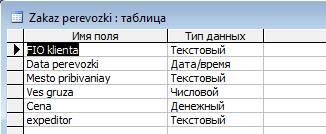
2.2.Diagrams.
2.2.1.Use case diagram.
External users are physical objects of various natures (from people and mechanisms to software) that transmit or receive information for the system;
Usage blocks – groups of system functions that are combined into a single whole for an external user;
Designed to display time dependencies that arise in the process of communication between objects. A sequence diagram only shows those objects that are directly involved in the interaction and does not show possible static associations with other objects. For the diagram, the key point is precisely the dynamics of the interaction of objects over time. In this case, the sequence diagram has two dimensions. One - from left to right in the form vertical lines, each of which depicts the life line of a separate object participating in the interaction. Graphically, each object is depicted as a rectangle and is located at the top of its life line. Inside the rectangle are the object name and the class name, separated by a colon.

2.2.3.Action diagram.
Shows the execution of operations. The purpose of this diagram is to show the control flow internal to an operation. The action diagram is divided into 2 stripes, which include a specific set of actions and transitions. Each bar has its own name: client and sales manager, and thus allows you to group actions into a single whole. Graphically, each bar represents a vertical division of the chart using a solid bar. Each action can only be in one lane, and transitions can cross lanes.

2.2.4. Cooperation diagram.
The main feature of a cooperation diagram is the ability to graphically represent not only the sequence of interaction, but also all the structural relationships between the objects participating in this interaction. The diagram in the form of rectangles depicts the objects participating in the interaction, containing the name of the object, its class: selection of an order option, form of order details, order manager, order, general manager. Next on the diagram, associations between objects are indicated in the form of various connecting lines. Dynamic connections between objects are depicted - message flows - in the form of connecting lines, above which there is an arrow indicating the direction, message name, and sequence number in the general sequence of message initialization.
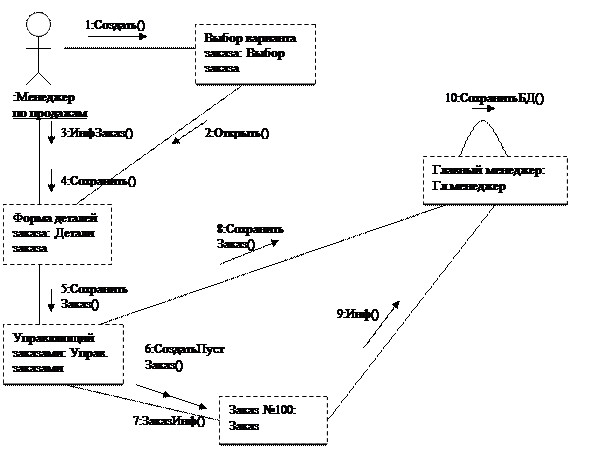
2.2.Diagrams.
2.2.Use case diagrams.
Use case diagrams describe the functionality of a system or what the system is supposed to do. The diagram includes the following elements:
External users are physical objects of various natures (from people and mechanisms to software) that provide or receive information for the system;
Usage block – groups of system functions that are combined into a single whole for an external user;
Connections between usage blocks and connections between usage blocks and external users.

2.2.2.Sequence diagram.
Designed to display time dependencies that arise in the process of communication between objects. A sequence diagram only shows those objects that are directly involved in the interaction and does not show possible static associations with other objects. In the constructed diagram, the objects are: client, cashier, crew. For the diagram, the key point is precisely the dynamics of the interaction of objects over time. In this case, the sequence diagram has two dimensions. One is from left to right in the form of vertical lines, each of which depicts the life line of a separate object participating in the interaction. Graphically, each object is depicted as a rectangle and is located at the top of its life line.
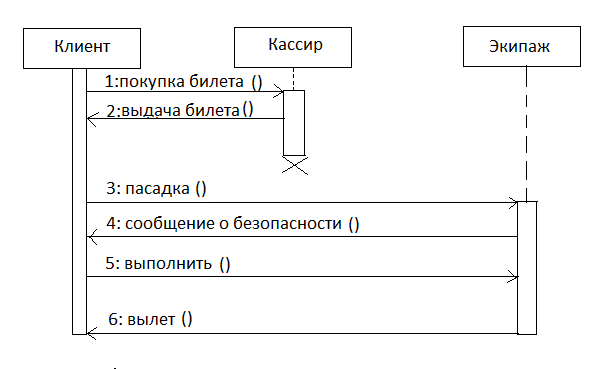
2.3.Instructions for the user.
This application represented by a button interface - this is the user interface with the database, it is developed individually for each application, it is a user form that contains all database objects. This form contains buttons for working with application data: accounting, ordering, calculating expenses, choosing a car. By clicking these buttons you will be able to see all the information about the store computer equipment. The form is also for making changes to the application. In the lower right corner there is a button to exit this application.
3.Description of hardware and software.
To write the database, the MS Access database management system was chosen. Due to the fact that currently enterprises mainly use Pentium 3 and higher computers, Windows 2000, ME, XP, Vista operating systems and the MS Office office suite. Therefore, to develop our application, we chose this type of operating system, version Word programs and Access and Rational Rose software.
Brief characteristics of the Windows 7 operating system
Microsoft Windows 7 Professional is the latest operating system, the optimal solution for both working at home and in the office. Provides advanced functions for business, entertainment, storage, archiving, protection and recovery of information. Supports secure connection to corporate networks via domain.
Take full advantage of the latest hardware resources with the new Windows 7 OS! Microsoft Windows 7 Professional is a flexible operating system tailored to perform business tasks.
Key Windows features 7 Professional:
Significant increase in productivity: quick start and shutdown, quickly switching sessions and modes.
· System resource management modules, optimization of load distribution, protection against unexpected failures and freezes, automatic system diagnostics invisible to the user.
Intelligent search acceleration technology necessary files and programs and a convenient system for viewing search results. Any item from your archives saved under Windows 7 can now be found in a matter of minutes!
· Built-in web search option via Windows Internet Explorer 7.
· Watch, pause, rewind and record TV programs with using Windows Media Center.
· System parental controls to prevent unauthorized use and block unwanted data.
Flexible system Microsoft settings Windows 7 Professional.
· Ensuring device compatibility, providing all necessary drivers through Windows Update.
· Ensuring full compatibility of applications within the system, built-in compatibility tools.
· Ability to easily transfer data and settings from an old PC to a new one.
Additional features Windows 7 Professional:
· Fundamental security features: protecting the kernel from changes, strengthening the protection of services, preventing unauthorized data execution, protecting against accidental changes to the address space structure, maintaining required integrity levels.
· Increased battery life by reducing the total number of background tasks, diagnosing the causes of excessive energy consumption, automatic saving power supply during idle time, dimming the display brightness, sleep mode, etc.
· Design support for 64-bit processors.
· For IT specialists, Microsoft Windows 7 Professional provides work via command line, support for WMI scripts for viewing system stability analysis tool (RAC) data, system stability monitoring.
Video report: New features of Windows 7. Booting the system from a VHD disk
· One of the most interesting and long-awaited features in Windows 7 is support for virtual files hard drives VHD as usual physical drives. The report discusses the process of installing and loading the operating system from VHD file, allowing you to get acquainted with the new operating system without affecting the OS currently installed on the computer.
Conclusion
The purpose of this work was to create a “cargo transportation” information system. This system is intended to function as a cargo transportation management campaign. This application was written in Rational Rose, and the database was created in MS Access.
While working on this product, I learned methods for creating and designing databases, and learned how to develop diagrams various types. Nowadays, storing, retrieving and accessing information has become an important phenomenon. Using this product in a computer hardware store allows you to reduce all human costs and efforts, and most importantly, promptly provide the results required by the employee, and also replace large archives with structured storage in electronic form.
I also learned about cargo transportation companies and how they operate.
Rational Rose Software Brief Features
Rational Rose, unlike similar design tools, is capable of designing systems of any complexity, that is, the program tools allow both high-level (abstract) representation (for example, an enterprise automation diagram) and low-level design (program interface, database schema, partial description of classes). All the power of the program is based on just 7 diagrams, which, depending on the situation, can describe various actions.
1. Analysis of requirements for automated information systems / Internet University Information technologies. http://www.INTUIT.ru.
2. Buch G. Object-oriented design with examples of application / Transl. from English / G.Buch. – M.: Concord, 1992.
3. Vendrov A.M. CASE technologies. Modern methods and tools for designing information systems. – M.: Finance and Statistics, 1998.
4. Gvozdeva T.V. Information systems design: tutorial. – Rostov n/d: Phoenix, 2009.
5. Gvozdeva T.V. Information systems design. Part 1. Methods of structural analysis. Planning and project management: laboratory workshop / State Educational Institution of Higher Professional Education "Ivanovo State Energy University named after V.I. Lenin". – Ivanovo, 2005.
6. Paronjanov S.D. Methodology for creating corporate IP. Argussoft company. 96, http:///www.citforum.ru/database/kbd96/43.shtml.
7. Design of information systems: textbook for universities / ed. K.I.Kurbakova. M.: Russian Economic Academy, 2000.
8. Fomenkov S.A. Lectures on the modeling course. http://vstuhelp.narod.ru.
9. Cheremnykh S.V. Modeling and analysis of systems: IDEF technologies: workshop / S.V. Cheremnykh. – M.: Finance and Statistics, 2002.
10. Cheremnykh S.V. Structural analysis of systems: IDEF technologies: workshop / S.V. Cheremnykh. – M.: Finance and Statistics, 2003.
Ingruz
Freight software
The page presents a selection of software for conducting activities and accounting in the field of cargo transportation and logistics. Software systems are specially designed for forwarders, carriers, dispatchers and allow for document flow and accounting in transport companies. It will also be useful for you to know what used in cargo transportation and logistics at motor transport enterprises. We are offering to you short review By the best programs for cargo transportation with brief description, photos and prices.
Review of the best software systems in the field of cargo transportation and logistics
1. CARGO TRANSPORTATION PROGRAM
The Cargo Transportation program allows you to accept and control requests for transportation, storage, transshipment, loading, unloading, insurance, etc. services for standard, consolidated, oversized, multimodal and other types of cargo. There are tariff schedules, accounting for fuel and lubricants, warehouse accounting, planning and control of vehicle repairs, salary calculation, generation of all types of documentation, as well as various types of reports, analysis and control of debts, calculation of profitability for transport, managers and the entire enterprise as a whole. Sending e-mail, SMS, built-in verification of counterparties based on many parameters in the “Contour.Focus” system.
If you want the program to work via the Internet, contact the developers. They will advise you for free on how to set up the Freight Transportation program for remote work via the Internet.
Rates:
- Buy the Freight Transportation program with a one-time payment for an unlimited time:
- License for 1 workplace- 5,800 rub.;
- License for 5 workplaces - 23,000 rubles;
- License for 10 workplaces - 40,000 rubles;
- License without limiting the number of jobs - 60,000 rubles.
- Rent the Cargo Transportation program for 6 months:
- Buy the Cargo Transportation program in installments for 1 year without additional extra charge:
- License for 1 workplace - 1,000 rubles;
- License for 5 workplaces - 5,000 rubles;
- License for 10 workplaces - 10,000 rubles;
- License without limiting the number of jobs - 20,000 rubles.
Read more about tariff plans read on cargo transportation program.rf
Video review:
Demo version with a period of 30 days. Answers to any questions about the program. Free remote presentation. Help with installation and configuration.
2. SMART LOGISTICS

The online service "Smart Logistics" allows you to accept and process customer orders, automatically place and search for applications for cargo or transport on the website ati.su, monitor the work of logisticians, maintain a database of drivers, cargo, contracts and contractors, generate reports and maintain accounting, track profitability companies.
Rates:
- Smart logistics offers only 2 tariffs: “constructor” and “all inclusive”;
- Tariff “designer” - 99 rubles. per day / 2999 rubles per month;
- All inclusive rate - 299 rubles. per day / 8999 rubles per month.
Video review:
Possibility of free testing:
There is a trial period: on request
3. CyberLog

The Kiberlog information system allows you to manage basic business processes in the field of cargo transportation, ensure timely exchange of information and maintain correct document flow with customers and cargo carriers.
Rates:
- Kiberlog developers offer 3 tariffs: “standard”, “organization” and “corporate”;
- Tariff “standard” - 450 rub. per month per user (up to 4 users);
- Tariff "organization" - 425 rubles. per month per user (up to 20 users);
- Tariff "corporate" - 400 rubles. per month per user (from above 20 users).
Possibility of free testing:
There is a trial period: 1 month
4. LOGISTICS DEPARTMENT
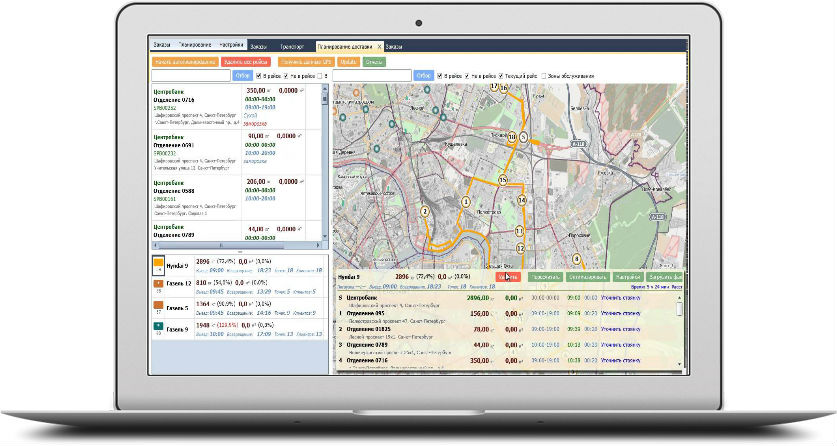
“Logistics Department” or “Logistics Tools 24” - cloud service for running a business in the field of cargo transportation, which helps to significantly reduce transportation costs by building optimized routes, loading based on body parameters and distributing orders among vehicles.
Rates:
- Tariffs in open access not specified, on request.
Video review:
Possibility of free testing:
There is a test period: 14 days.
5. ROAD TRANSPORTATION 4
![]()
The “road transportation 4” program keeps records of fuel and lubricants and waybills, stores information about drivers, vehicles, clients, speedometer readings, driver work time, calculates many indicators and generates a ready-made report.
Rates:
- The Autosoft company offers several packages with a lifetime license and a one-time payment;
- License - 10,000 rub. (Basic package);
- License - 5000 rub. (Additional license);
- License - 16,000 rub. (Package for 3 jobs);
- License - 18,000 rub. (Package for 5 jobs).
It should be noted that AutoSoft specializes in the development of software for automating business processes in transport enterprises and related industries.
Possibility of free testing:
There is a trial period: 14 days
6. NovaTrans

The online service allows you to automate all processes in a transport enterprise. By using of this service you can easily create and control applications, keep records of acts and personal registration documents, generate salaries and reports.
Rates:
- Novatrans developers offer 2 tariffs: “light” and “unlimited”;
- Tariff “light” - 400 rub. per user per month (from 1 to 4 users);
- Tariff “unlimited” - 2000 rubles. per user per month (5 or more users).
Possibility of free testing:
There is a trial period: 15 days
7. ABMRinkai

A cloud service from the Czech company ABM Rinkai TMS is designed for automatic and optimal planning of delivery routes, while the service takes into account all restrictions and selects the best route in terms of cost and technical capabilities of freight transport.
Video review:
Rates:
- Tariffs in public access not specified, on request
Possibility of free testing:
There is a trial period: on request.
8. 1C Forest: Motor transport
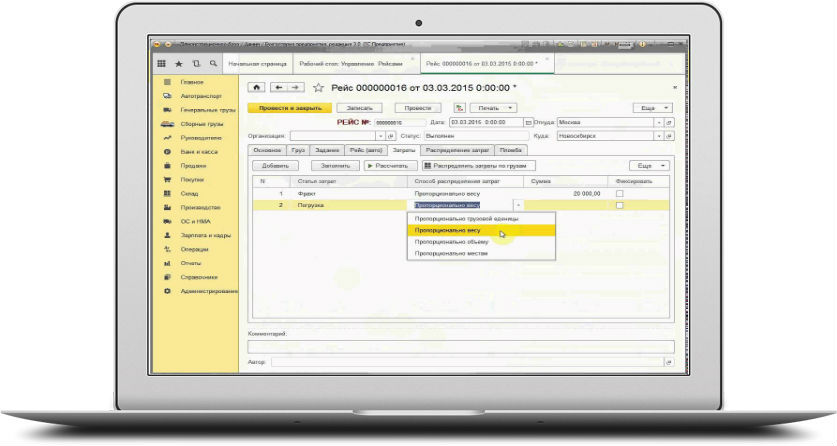
The “Vehicle Accounting” configuration on the 1C 8 platform is designed for vehicle accounting at any enterprise that has vehicles. Takes into account spare parts, fuels and lubricants, waybills and other inventory items at the enterprise. With this configuration you can control Maintenance and number of vehicles.
Rates:
- Lifetime license - RUB 45,000.
Possibility of free testing:
Demo version available: upon request
9. 1C-Rarus: Transport logistics
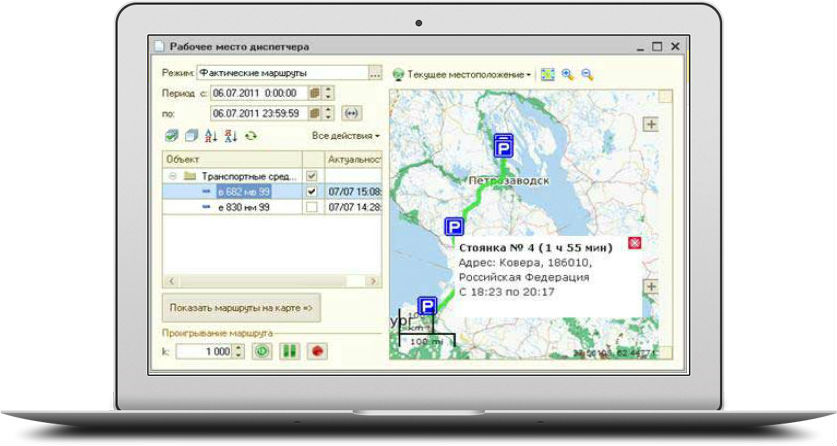
“Transport logistics” from the 1C company is an automated solution for management and operational accounting in motor transport enterprises, as well as in transport departments of trading, manufacturing and other companies with various industry specifics.
Rates:
- Lifetime license - 58,000 rubles;
- Rent - 1340 rub. per month per user.
Possibility of free testing:
Demo version available: upon request
10. TransTrade
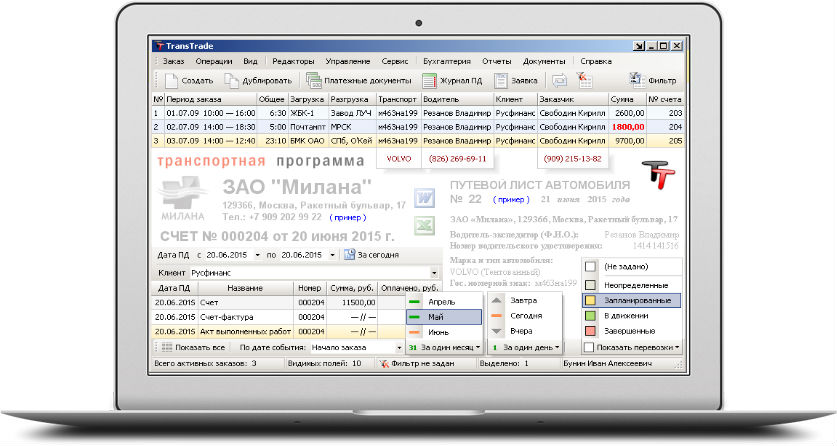
TransTrade - the program automates any transport logistics departments whose field of activity is related to cargo transportation and solving transport problems. In the program you can register all the necessary information about transportation, the names of cargo owners and transport companies, private carriers, subcontractors, generate, view and print reports. Calculate the cost of transportation at fixed rates or based on mileage, weight and volume of cargo.
Rates:
- TransTrade offers tariffs with lifetime licenses with a one-time payment;
- Tariff "IP" - 3500 rub. (1 user);
- Tariff “Duet” - 5000 rub. (2 users);
- Tariff "Trio" - 7200 rub. (3 users);
- Tariff “Team” - 8800 rub. (5 users);
- Tariff “Collective” - 12,200 rubles. (10 users);
- Tariff "Business circle" - 18,600 rubles. (15 users);
- Tariff “Corporate Unlimited” - 32,800 rubles. (no limits).
The license cost is the price of the program in its basic configuration, excluding additional modules. You will have to purchase additional modules separately.
Possibility of free testing:
There is a demo version: software limitations do not allow you to create more than 10 orders in the system.
11. BIT:Motor transport

Another complex developed on the basis of 1C: Enterprise 8 is BIT: Autotransport. Designed to comprehensively automate business management processes in motor transport and logistics companies of any size and industry that have their own vehicles. This group includes manufacturing, agricultural, trading and motor transport enterprises.
Rates:
- The company offers lifetime licenses with a one-time fee;
- License - 5,000 rub. (for 1 workplace);
- License - 22,000 rub. (for 5th workplace);
- License - 39,000 rub. (for 10 workplaces);
- License - 72,000 rub. (for 20 workplaces);
- License - 169,000 rub. (for 50 workplaces);
- License - 300,000 rub. (per 100 workplace);
- License - 500,000 rub. (for 200 workplaces).
Possibility of free testing:
Demo version available: upon request
12. TransManager

The TRANS-Manager software has the full range of functionality required by most freight forwarding enterprises. The main purpose of the complex is control, accounting, analysis and functionality. According to the developers themselves, they are not producing something new, but are finalizing the project taking into account the wishes of existing users of the program.
Rates:
- The company offers lifetime licenses with a one-time fee;
- License - 4999.00 rub. (1 user);
- License - 9898.00 rub. (2 users);
- License - 14697.00 rub. (3 users);
- License - 19396.00 rub. (4 users);
- License - 23995.00 rub. (5 users);
- License - 28494.00 rub. (6 users);
- License - 32893.00 rub. (7 users);
- License - 37193.00 rub. (8 users);
- License - 41392.00 rub. (9 users);
- License - 45491.00 rub. (10 users);
- License - 49490.00 rub. (no limits).
Possibility of free testing:
There is a trial period: 14 days
13. Control and accounting of vehicles

"Control and accounting of vehicles" allows you to quickly generate documents and reports. The program contains standard forms of waybills and various transport reports. You can generate a fuel report from the intake limit card. Automatic notification will remind you when you need to undergo the next maintenance, renew or change your insurance policy.
Rates:
- The developer offers licenses with a one-time payment, but if an update is released, you will have to pay 50% of the license cost;
- License - 2,800 rub. (up to 100 cars);
- License - 4,000 rub. (no limits).
Possibility of free testing:
There is a trial period: 30 days
14. Formula Management PATP

The 1C configuration for carrier companies on regular bus routes allows you to manage passenger transportation. Generate daily orders and route sheets, place orders for vehicles. This configuration can interact with vehicle monitoring systems (GPS/GLONASS), as well as keep records of fuel consumption, repairs and maintenance, tires, and batteries. Maintains tariffs for transport services, calculates their costs and generates various invoices and acts.
Rates:
License - 65,400 rub. (per 1 workplace).
Possibility of free testing:
There is a demo version: by agreement.
15. CargoTsRM

CargoCRM is professional software that allows you to automate the process of cargo transportation, both domestic and international). Using CargoCRM software, you can manage requests, transport flow, contacts, minimize costs, increase the productivity of forwarders and transport company managers.
Rates:
- License - 99 euros (one workplace).
Payment in installments is possible (50/25/25): initial payment 50% of the cost, next payment 25% of the cost and final payment 25%.
Possibility of free testing:
Demo version available: upon request
16. KorsAutoenterprise
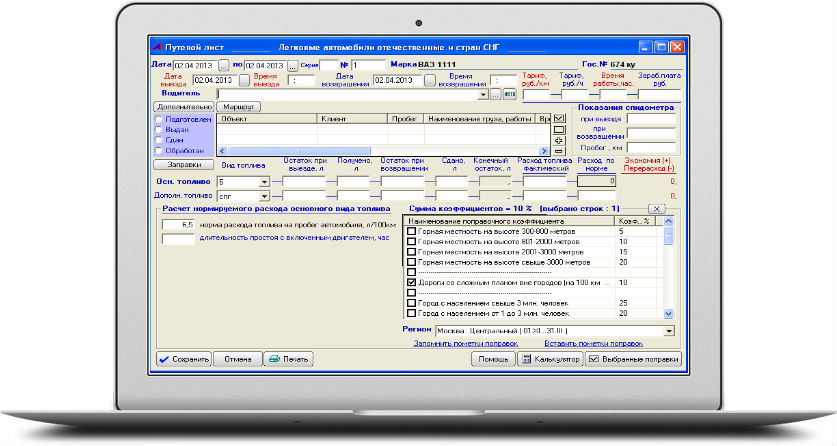
Kors Autoenterprise - software for accounting of waybills, transport, fuels and lubricants. Compiles routes for vehicles at transport enterprises. The program contains standard forms of waybills for the most common types of equipment. (cars, trucks, buses, cranes, dump trucks, etc.).
Rates:
- Developers offer licenses with a one-time payment;
- The cost of the program is 2,600 rubles;
- The cost of the network version is 5,200 rubles.
Possibility of free testing:
There is a demo version: upon request Demo version with restrictions. Before purchase - no more than 40 waybills, no more than 40 income/expense records.
Bottom line:
Choose a software package based on your tasks and goals that you set in the field of logistics. Each program has a test period or demo version, so test it, see which software is right for you, and then buy it.
In fact, you can do without expensive programs; the database of customers, carriers, cargo owners, routes, prices can be maintained, for example, in Excel. Prepare in advance for the carriage of goods (contract form, applications, tons, power of attorney, waybill) and fill in the necessary data each time. Find out which ones are used in cargo transportation. To get started, this arsenal will be enough for you.
Federal Agency for Education of the Russian Federation
Branch of the State Educational Institution of Higher Professional Education "Saratov State Technical University" in Petrovsk
Course work
Discipline: “Software Product Development Technology”
Topic: Development of a cargo transportation information system
Completed by: 3rd year student
Specialties 230105.51
"Computer software and automated systems"
Shikhin Gleb
Checked by: teacher
Trubkina Yu.A
Petrovsk 2010
| Introduction I. Technical specifications 2.Carrying out research work 2.1.Define input and output data structures 2.2. Requirements for the composition and parameters of PC hardware 2.3. Requirements for information and software compatibility II. Economical project. Explanatory note 1. Justification for the need to develop an application 2. Statement of the development problem, description of solution methods 2.1.Database structure 2.2.Diagrams 2.2.1 Sequence diagram 2.2.2.Sequence diagram 2.2.3.Action diagram 2.2.4.Diagram 2.3.User instructions 3.Description and rationale for choosing the composition of hardware and software Brief characteristics of the Windows XP operating system Conclusion Bibliography |
Introduction
The topic of my course work is Development of an information system “Cargo Transportation”. Technological delivery operations, both necessary, determined by economic relations, and unnecessary, can be carried out in terms exceeding the normative ones and, in addition, using related elements (warehouses, transport, means of mechanization of cargo operations, etc.) according to their technical and economic characteristics (productivity, cost, etc.) different from the planned ones.
Assessment of the economic efficiency of container servicing of production, transport and warehouse systems should be carried out on the basis commensurate the costs of delivering products prior to the implementation of the container system and the results obtained by the serviced system after the implementation of the container system.
In accordance with the economic essence of the processes of functioning of container systems, the main arguments that form their economic efficiency are an increase in labor productivity, a reduction in material and labor costs, as well as an increase in the reliability of contractual production, transport and warehouse connections that underlie the serviced systems and their processes. implementation.
Assessing the economic efficiency of container services based on the criterion of the reduced costs of carrying out the product delivery process provides the most complete accounting of the factors that determine the amount of efficiency.
The container is loaded onto a ship in New York and follows a direct flight to Rotterdam, where associated containers and empty units are unloaded/loaded, and information about the driven container is updated. The ship sets out on a voyage to St. Petersburg, where the container is unloaded and, after passing customs and other formalities, it proceeds to its destination by mainline (railway) or motor transport. If the container is loaded onto the main platform, then it is delivered “to the door” again by road.
I. Technical specifications
Application name – IS “Airport”
2.Carrying out research work:
2.1. Determination of the structure of input and output data.
Develop an information system that provides work with a database that includes records like:
| Freight transportation |
|||
| Podshita rashodov |
vibor mashini dlay perevozki |
||
2.2. Requirements for the composition and parameters of PC technical equipment.
External devices, their characteristics.
To operate this application, the program requires a PC with a microprocessor 1.6 GHz or higher, 512 Mb RAM, 80 Gb hard drive, NVIDIA GeForce 8600 GTS video adapter, monitor, mouse, keyboard, printer.
2.3. Requirements for information and software compatibility.
To operate the application, you need the Windows 7 operating system, MS Access database management system, MS Word text editor, and Rational Rose software design program.
II.Sketch design. Explanatory note (GOST 19.404-78)
Name of applications – IS “freight transportation”
1. Justification for the need to develop the application:
Rationale for development - writing a term paper
Purpose for development - this application is a database that is designed for the successful and convenient operation of the airport.
2. Statement of the development problem, description of solution methods:
2.1.Database structure.
Table "Buhgalteriya"
Table "Podshita rashodov"

Table “vibor mashini dlay perevozki”

Table "Zakaz perevozki"

2.2.Diagrams.
2.2.1.Use case diagram.
External users are physical objects of various natures (from people and mechanisms to software) that transmit or receive information for the system;
Usage blocks – groups of system functions that are combined into a single whole for an external user;
![]()
Designed to display time dependencies that arise in the process of communication between objects. A sequence diagram only shows those objects that are directly involved in the interaction and does not show possible static associations with other objects. For the diagram, the key point is precisely the dynamics of the interaction of objects over time. In this case, the sequence diagram has two dimensions. One is from left to right in the form of vertical lines, each of which depicts the life line of a separate object participating in the interaction. Graphically, each object is depicted as a rectangle and is located at the top of its life line. Inside the rectangle are the object name and the class name, separated by a colon.

2.2.3.Action diagram.
Shows the execution of operations. The purpose of this diagram is to show the control flow internal to an operation. The action diagram is divided into 2 stripes, which include a specific set of actions and transitions. Each bar has its own name: client and sales manager, and thus allows you to group actions into a single whole. Graphically, each bar represents a vertical division of the chart using a solid bar. Each action can only be in one lane, and transitions can cross lanes.

2.2.4. Cooperation diagram.
The main feature of a cooperation diagram is the ability to graphically represent not only the sequence of interaction, but also all the structural relationships between the objects participating in this interaction. The diagram in the form of rectangles depicts the objects participating in the interaction, containing the name of the object, its class: selection of an order option, form of order details, order manager, order, general manager. Next on the diagram, associations between objects are indicated in the form of various connecting lines. Dynamic connections between objects are depicted - message flows - in the form of connecting lines, above which there is an arrow indicating the direction, message name, and sequence number in the general sequence of message initialization.

2.2.Diagrams.
2.2.Use case diagrams.
Use case diagrams describe the functionality of a system or what the system is supposed to do. The diagram includes the following elements:
External users are physical objects of various natures (from people and mechanisms to software) that provide or receive information for the system;
Usage block – groups of system functions that are combined into a single whole for an external user;
Connections between usage blocks and connections between usage blocks and external users.

2.2.2.Sequence diagram.
Designed to display time dependencies that arise in the process of communication between objects. A sequence diagram only shows those objects that are directly involved in the interaction and does not show possible static associations with other objects. In the constructed diagram, the objects are: client, cashier, crew. For the diagram, the key point is precisely the dynamics of the interaction of objects over time. In this case, the sequence diagram has two dimensions. One is from left to right in the form of vertical lines, each of which depicts the life line of a separate object participating in the interaction. Graphically, each object is depicted as a rectangle and is located at the top of its life line.

2.3.Instructions for the user.
This application is represented by a push-button interface - this is the user interface with the database, it is developed individually for each application, it is a user form that contains all database objects. This form contains buttons for working with application data: accounting, ordering, calculating expenses, choosing a car. By clicking these buttons, you will be able to see all the information about the computer hardware store. The form is also for making changes to the application. In the lower right corner there is a button to exit this application.
3.Description of hardware and software.
To write the database, the MS Access database management system was chosen. Due to the fact that currently enterprises mainly use Pentium 3 and higher computers, Windows 2000, ME, XP, Vista operating systems and the MS Office office suite. Therefore, to develop our application, we chose this type of operating system, versions of Word and Access programs, and the Rational Rose program.
Brief characteristics of the Windows 7 operating system
Microsoft Windows 7 Professional is the latest operating system, the optimal solution for both working at home and in the office. Provides advanced functions for business, entertainment, storage, archiving, protection and recovery of information. Supports the ability to securely connect to corporate networks via a domain.
Take full advantage of the latest hardware resources with the new Windows 7 OS! Microsoft Windows 7 Professional is a flexible operating system tailored to perform business tasks.
Key features of Windows 7 Professional:
· Significant increase in productivity: fast startup and shutdown, fast switching of sessions and modes.
· System resource management modules, optimization of load distribution, protection against unexpected failures and freezes, automatic system diagnostics invisible to the user.
Intelligent technology to speed up the search for necessary files and programs and a convenient system for viewing search results. Any item from your archives saved under Windows 7 can now be found in a matter of minutes!
· Built-in web search option via Windows Internet Explorer 7.
· Watch, pause, rewind and record TV programs using Windows Media Center.
· Parental control system to prevent unauthorized use and block unwanted data.
· Flexible configuration system for Microsoft Windows 7 Professional.
· Ensuring device compatibility, providing all necessary drivers through Windows Update.
· Ensuring full compatibility of applications within the system, built-in compatibility tools.
· Ability to easily transfer data and settings from an old PC to a new one.
Additional features of Windows 7 Professional:
· Fundamental security features: protecting the kernel from changes, strengthening the protection of services, preventing unauthorized data execution, protecting against accidental changes to the address space structure, maintaining required integrity levels.
· Increased battery life by reducing the total number of background tasks, diagnosing the causes of excessive energy consumption, automatically saving power during idle time, reducing display brightness, sleep mode, etc.
· Design support for 64-bit processors.
· For IT specialists, Microsoft Windows 7 Professional provides command line work, support for WMI scripts for viewing system stability analysis tool (RAC) data, and system stability monitoring.
Video report: New features of Windows 7. Booting the system from a VHD disk
· One of the most interesting and long-awaited features in Windows 7 is support for VHD files as regular physical drives. This talk covers the process of installing and booting an operating system from a VHD file, allowing you to become familiar with the new operating system without affecting the OS currently installed on your computer.
Conclusion
The purpose of this work was to create a “cargo transportation” information system. This system is designed to function as a cargo transportation management campaign. This application was written in Rational Rose, and the database was created in MS Access.
While working on this product, I learned methods for creating and designing databases, and learned how to develop various types of diagrams. Nowadays, storing, retrieving and accessing information has become an important phenomenon. Using this product in a computer hardware store allows you to reduce all human costs and efforts, and most importantly, promptly provide the results required by the employee, and also replace large archives with structured storage in electronic form.
I also learned about cargo transportation companies and how they operate.
Rational Rose Software Brief Features
Rational Rose, unlike similar design tools, is capable of designing systems of any complexity, that is, the program tools allow both high-level (abstract) representation (for example, an enterprise automation diagram) and low-level design (program interface, database schema, partial description of classes). All the power of the program is based on just 7 diagrams, which, depending on the situation, can describe various actions.
1. Analysis of requirements for automated information systems / Internet University of Information Technologies. http://www.INTUIT.ru.
2. Buch G. Object-oriented design with examples of application / Transl. from English / G.Buch. – M.: Concord, 1992.
3. Vendrov A.M. CASE technologies. Modern methods and tools for designing information systems. – M.: Finance and Statistics, 1998.
4. Gvozdeva T.V. Design of information systems: textbook. – Rostov n/d: Phoenix, 2009.
5. Gvozdeva T.V. Information systems design. Part 1. Methods of structural analysis. Planning and project management: laboratory workshop / State Educational Institution of Higher Professional Education "Ivanovo State Energy University named after V.I. Lenin". – Ivanovo, 2005.
6. Paronjanov S.D. Methodology for creating corporate IP. Argussoft company. 96, http:///www.citforum.ru/database/kbd96/43.shtml.
7. Design of information systems: textbook for universities / ed. K.I.Kurbakova. M.: Russian Economic Academy, 2000.
8. Fomenkov S.A. Lectures on the modeling course. http://vstuhelp.narod.ru.
9. Cheremnykh S.V. Modeling and analysis of systems: IDEF technologies: workshop / S.V. Cheremnykh. – M.: Finance and Statistics, 2002.
10. Cheremnykh S.V. Structural analysis of systems: IDEF technologies: workshop / S.V. Cheremnykh. – M.: Finance and Statistics, 2003.



